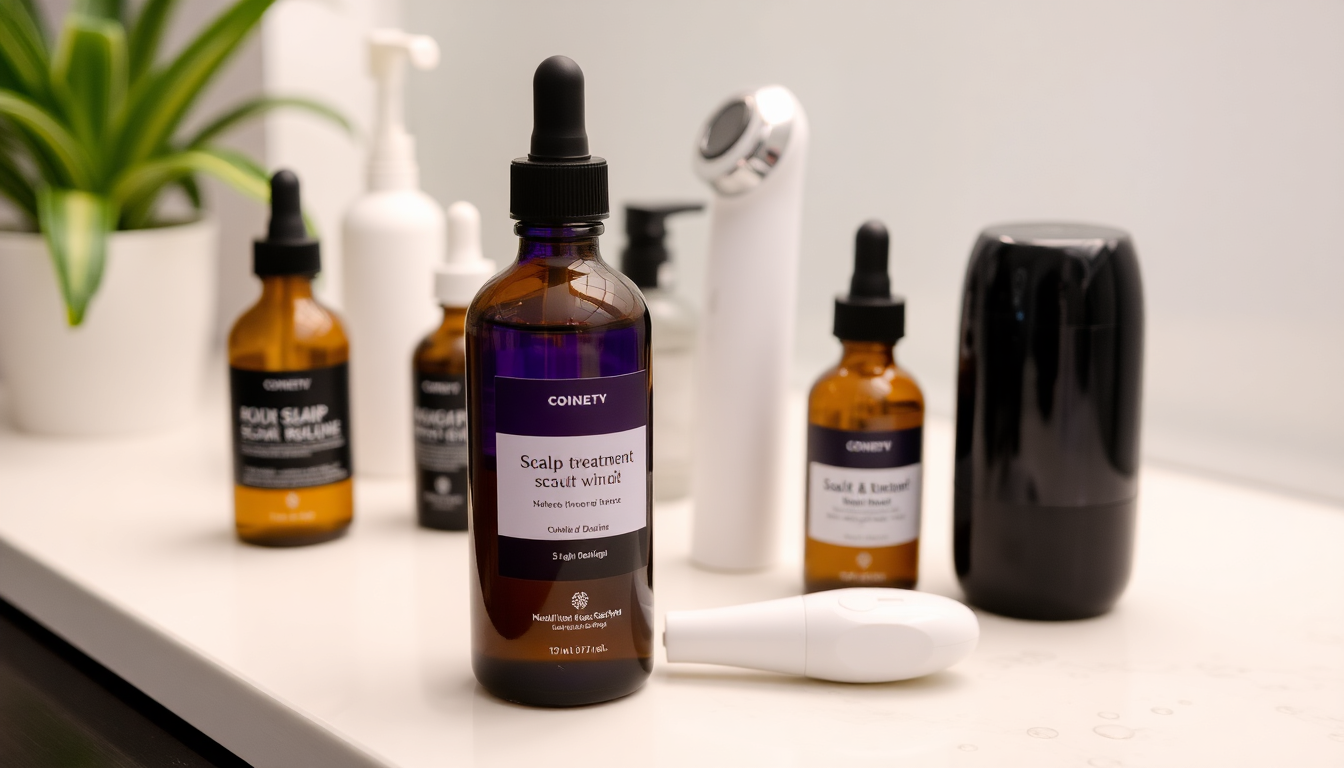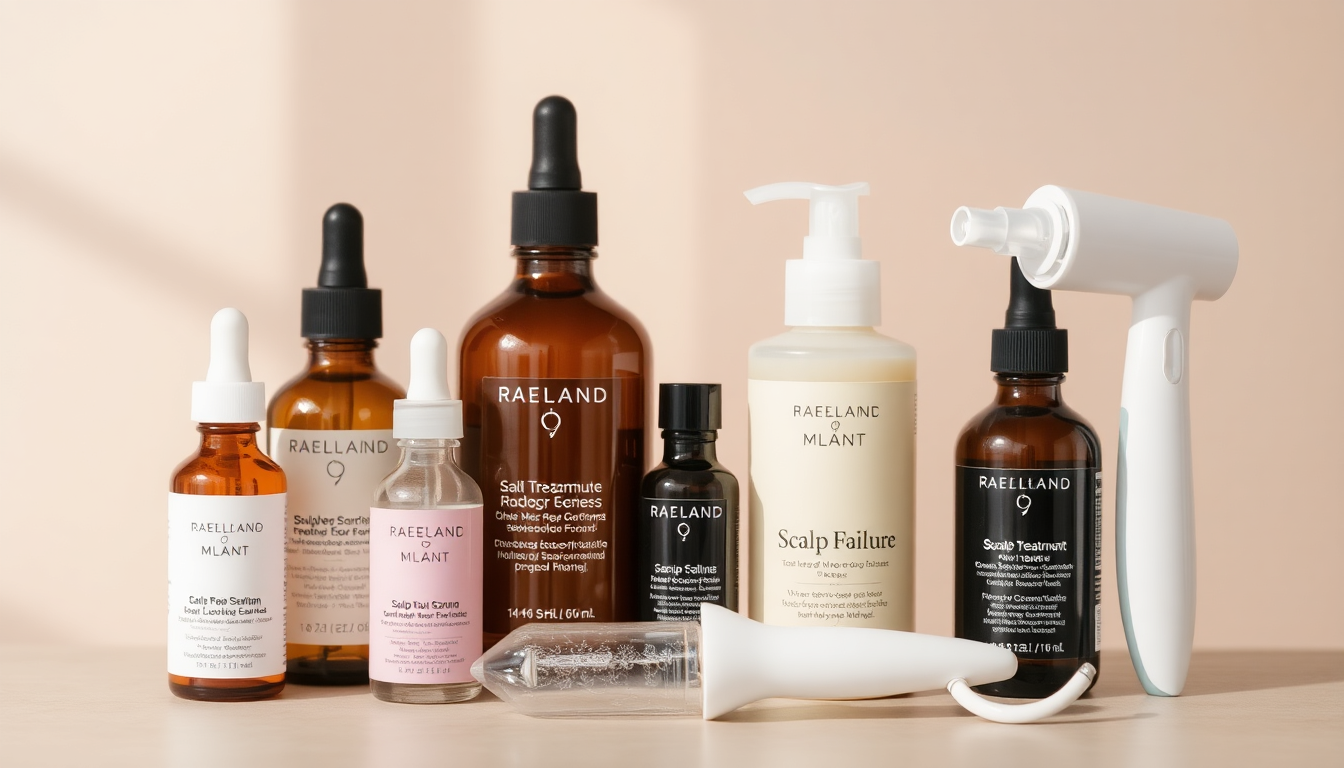Introduction
Improving hair density sustainably requires more than a single product or device — it needs a reproducible, evidence-informed layering protocol that respects scalp biology, product chemistry and device mechanics. This in-depth guide (updated 2025) explains the rationale and evidence behind the optimal order to use prebiotic scalp treatments, peptide serums and at-home scalp devices, and provides step-by-step protocols for beginners through advanced users.
Quick Protocol Summary (Short Version)
- Cleanse the scalp to remove oils and residues.
- Apply a prebiotic leave-on tonic to support the microbiome and barrier.
- Wait 2–5 minutes (allow absorption).
- Apply a lightweight peptide serum targeting follicles.
- Use devices according to type: microneedling generally before topical application (to boost uptake), LLLT can be used before or after, and massage devices can be used before or after depending on preference.
- Finish with a final seal or protective product only if it won't trap residue or irritate the scalp overnight.
Why Layering Matters: Biological and Practical Reasons
- Absorption and bioavailability: the order determines whether actives reach target tissues at effective concentrations.
- Microbiome and inflammation: prebiotics can reduce pro-inflammatory triggers, creating a healthier environment for peptide signaling.
- Device synergy and safety: devices alter permeability, blood flow and local biology — sequencing influences both benefit and irritation risk.
- Compliance and consistency: a simple, repeatable routine increases adherence, which matters more than sporadic aggressive interventions.
Science Snapshot: Mechanisms in Simple Terms
- Prebiotics: non-digestible ingredients that feed beneficial microbes, improving barrier and reducing scalp microinflammation.
- Peptides: short amino-acid chains that can signal dermal papilla cells, support extracellular matrix remodeling and reduce local catabolic signaling.
- LLLT (low-level laser/light therapy): red and near-infrared light increase mitochondrial activity (ATP), reduce oxidative stress and enhance microcirculation.
- Microneedling: controlled microinjury activates wound-healing pathways (growth factor release) and transiently increases topical absorption.
Deep Dive — Prebiotic Scalp Treatments: What They Do and Why They Come First
Prebiotic tonics and shampoos are designed to support the scalp's microbial ecosystem rather than kill microbes outright (contrast with antiseptics). A balanced scalp microbiome helps maintain barrier integrity, reduce itch/inflammation and prevent conditions like seborrheic dermatitis that can impair hair growth.
Key Ingredients to Look For
- Inulin or oligosaccharides (support commensal microbes)
- Bacterial fermentation extracts (modulate immune signaling)
- Panthenol (pro-vitamin B5, boosts barrier repair)
- Niacinamide (supports barrier and circulation)
- Low-irritant preservatives and minimal fragrance
Evidence and Rationale for Applying First
Applying prebiotics first helps normalize pH and provides a scaffold that can reduce irritant responses to later active ingredients or transdermal enhancement from devices. It prepares the scalp ecosystem, potentially increasing tolerance for peptides and device-enhanced absorption.
Peptide Serums: Types, Mechanisms and Practical Tips
Peptides used for hair density vary in structure and function. Some key classes and their putative actions:
- Copper peptides (e.g., GHK-Cu): promote extracellular matrix synthesis and wound-healing pathways; may support follicle health.
- Biomimetic peptides (e.g., matrikines): mimic natural signaling fragments to influence dermal papilla cells.
- Signal peptides (e.g., peptides that modulate growth factor pathways): support anagen maintenance.
Formulation Notes
- Choose serums with stable peptide formulations and a lightweight carrier (water-based serums or low-viscosity gels) for best penetration.
- Avoid heavy occlusive oils under devices unless specifically recommended.
- Look for pH-balanced products formulated for scalp skin (not just facial serums repurposed).
At-Home Scalp Devices: How They Work and Best Use
Devices commonly used at home include LLLT helmets/caps/comb devices, microneedling rollers/pens and mechanical scalp massagers. Each has distinct effects and sequencing rules.
LLLT (Low-Level Laser Therapy)
- Mechanism: increases mitochondrial function (ATP), modulates reactive oxygen species and can improve microcirculation.
- Parameters: typical devices use red (630–660 nm) and near-infrared (780–840 nm) light, treatment times 10–20 minutes, 3–5 sessions weekly for best evidence-based consistency.
- Sequencing: LLLT can safely be used before or after serums; many users apply LLLT then apply peptide serum to take advantage of increased circulation.
Microneedling
- Mechanism: creates microchannels and provokes controlled wound-healing, releasing growth factors and increasing topical uptake.
- Parameters: at-home devices typically use short needles (0.2–0.5 mm). Professional microneedling uses deeper needles; do not replicate clinical depth at home.
- Sequencing: perform microneedling before applying peptide serums if your product is clearly indicated for post-needling use. Apply within 5–30 minutes for enhanced delivery but only use non-irritating formulations.
- Frequency: at-home microneedling is often once weekly to once monthly depending on needle length and tolerance.
Mechanical Massage and Scalp Stimulators
- Mechanism: increases circulation, reduces tension, and may assist in dispersing topicals across the scalp surface.
- Sequencing: massage can be used before topicals (to warm and increase perfusion) or after (to help product distribution). Use gentle pressure and 5–10 minutes daily for best adherence.
Detailed Sequencing Decision Guide
Below is a logic-based stepwise decision tree to choose exact order based on your device and product characteristics:
- If you plan to microneedle and your peptide serum is formulated for post-needling use: Cleanse -> Microneedle -> Apply peptide -> Apply prebiotic later or in a separate session.
- If you use LLLT and non-irritating peptides: Cleanse -> Prebiotic -> Wait -> Peptide -> LLLT or Cleanse -> LLLT -> Prebiotic -> Peptide. Both orders are acceptable; many users prefer LLLT first then peptide.
- If you use massage devices: Cleanse -> Prebiotic -> Wait -> Peptide -> Massage (light) to disperse; or Massage first to increase circulation then apply prebiotic then peptide.
Protocols by Experience Level
Beginner Protocol (Daily, Low Irritation)
- Frequency: daily morning or evening routine.
- Steps: gentle cleanse every other day (or as required) -> apply prebiotic tonic -> wait 2–5 minutes -> apply lightweight peptide serum -> 5-minute manual scalp massage.
- Devices: introduce LLLT 3x/week for 10–15 minutes once comfortable.
Intermediate Protocol (Enhanced Uptake)
- Frequency: ongoing daily topicals; microneedling 1x/week (0.25–0.5 mm) and LLLT 3–5x/week.
- Steps: cleanse -> prebiotic -> wait -> microneedle session -> apply peptide serum (post-needling) -> LLLT or use LLLT separated by several minutes as desired.
Advanced Protocol (Close Monitoring, Professional Input Recommended)
- Frequency: combine device therapies under professional guidance; microneedling frequency reduced to avoid over-irritation.
- Steps: customized by practitioner; may include medical topical agents (e.g., minoxidil) combined with peptides and devices. Consult a dermatologist before combining prescription topicals with at-home devices.
How to Combine with Minoxidil or Other Prescription Treatments
- Minoxidil is commonly used for androgenetic hair loss. When using devices that increase absorption (microneedling), consult a clinician — needling can increase systemic absorption and local irritation.
- If using minoxidil: many clinicians advise applying minoxidil after needling with caution and under guidance; alternate-day schedules or temporarily pausing minoxidil around needling sessions may be recommended depending on tolerance.
Monitoring Progress: Objective and Subjective Metrics
- Photographic documentation: consistent lighting, distance and angles every 4 weeks.
- Hair counting: clip a defined 1 cm2 area and count hairs (clinician-guided).
- Patient-reported outcomes: satisfaction scales for fullness, shedding, itch, and overall scalp comfort.
- Scalp health: measure itch, redness and flaking to detect irritation early.
Troubleshooting (Expanded)
- Excessive irritation after device + topical: stop devices, use only prebiotic and simple peptide once daily, consult dermatologist.
- Persistent flaking or dermatitis: consider antiseptic or medicated shampoos short-term and consult a clinician; prebiotics help long-term but are not always sufficient for inflammatory scalp conditions.
- Plateau in results: reassess product strength, device usage consistency, and overall health factors (iron, thyroid, stress). Consider clinical evaluation.
Product Selection and Shopping Checklist
- Ingredient transparency: complete INCI list and concentrations where possible.
- Formulation tailored to scalp: non-comedogenic, low-viscosity for serums.
- Evidence or clinical testing: brands that publish stability data, clinical endpoints or third-party testing score higher for reliability.
- Device safety: CE or FDA-clearance where applicable for LLLT devices; clear instructions and customer support.
Illustrations and SEO-Friendly Alt Text
Visuals help readers understand order and device types. Example images (placeholders) with alt text containing target keywords:
Frequently Asked Questions (Expanded)
1. How long before I see improvements in hair density?
Expect to evaluate initial changes around 3–6 months and more meaningful density changes by 6–12 months with consistent use. Hair biology is slow; patience and consistent protocol adherence are essential.
2. Can I layer multiple serums (e.g., peptides + plant extracts)?
Yes, but prioritize lightweight peptide serums for direct follicle signaling and keep additional botanicals non-irritating. Use patch tests and introduce new products one at a time.
3. Are there risks using at-home devices?
Risks include local irritation, infection (microneedling if used improperly), and misuse of devices beyond recommended settings. Follow manufacturer guidance and consult a professional if unsure.
Clinical Considerations and When to See a Specialist
- Rapid or severe hair shedding or patchy loss warrants prompt clinical evaluation to rule out telogen effluvium, alopecia areata or scarring alopecias.
- Persistent scalp inflammation, pustules, or broken skin should be assessed before continuing device-based protocols.
- Complex regimens that combine prescription topicals with devices should be planned with a dermatologist.
SEO and Practical Tips for Long-Term Success
- Be consistent: set reminders, use treatment logs and standardized photos.
- Keep a simple baseline regimen and add devices or additional actives gradually.
- Read ingredient labels and avoid unnecessary fragrances or alcohols on sensitive scalps.
Where to Find Curated Products and Why Eelhoe Could Help
If you prefer a curated approach with products formulated specifically for scalp layering, consider brands that publish ingredient transparency and usage guidance. For example, explore Eelhoe's targeted ranges for prebiotic scalp tonics, peptide serums for hair density and compatible advanced scalp devices via these links: prebiotic scalp treatments, peptide serums for hair density and advanced scalp devices. These pages provide product details and recommended usage that align with the protocols described above.
Example 12-Week Plan (Practical)
Week 1–4 (Establish baseline and tolerance)
- Daily: gentle cleansing (2–3x/week), prebiotic tonic, peptide serum, 5-min massage.
- LLLT: 3x/week 10 minutes after peptide application or before — pick one and remain consistent.
- Microneedling: avoid during first 4 weeks while building tolerance.
Week 5–8 (Introduce microneedling)
- Microneedling: 0.25–0.5 mm once every 7–14 days. Cleanse, microneedle, apply peptide serum within 10–20 minutes if the serum is suitable for post-needling use.
- LLLT: continue 3–5x/week.
Week 9–12 (Assess and optimize)
- Review photos and scalp health metrics every 4 weeks.
- Adjust frequency: if irritation present, reduce needling and simplify topicals; if tolerating well, continue protocol and consider professional assessment for advanced options.
Conclusion and Invitation
Optimizing hair density is a combination of supporting scalp health (prebiotics), signaling follicle biology (peptide serums) and using device-based stimulation where appropriate. The evidence-based layering approach — cleanse, prebiotic, peptide, device (with device-specific adjustments) — balances efficacy and safety. Track progress, be patient and consult a specialist for complex cases.
If you want a practical place to start, explore Eelhoe’s curated collection of scalp-focused products designed for layering: Eelhoe prebiotic scalp treatments, Eelhoe peptide serums for hair, and Eelhoe scalp devices. Visit the Eelhoe store to compare formulations and select starter kits that match the protocols described above.
Disclaimer: This article summarizes current best-practice mechanisms and practical tips as of 2025 for informational purposes only. It does not replace medical advice. For personalized diagnosis and treatment — especially if you have rapid hair loss, scalp infection, or are using prescription treatments — consult a dermatologist or licensed clinician.




اترك تعليقًا
تخضع جميع التعليقات للإشراف قبل نشرها.
This site is protected by hCaptcha and the hCaptcha Privacy Policy and Terms of Service apply.